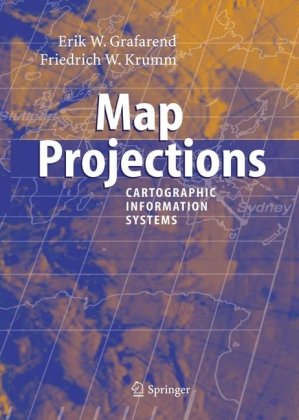

Most ebook files are in PDF format, so you can easily read them using various software such as Foxit Reader or directly on the Google Chrome browser.
Some ebook files are released by publishers in other formats such as .awz, .mobi, .epub, .fb2, etc. You may need to install specific software to read these formats on mobile/PC, such as Calibre.
Please read the tutorial at this link: https://ebookbell.com/faq
We offer FREE conversion to the popular formats you request; however, this may take some time. Therefore, right after payment, please email us, and we will try to provide the service as quickly as possible.
For some exceptional file formats or broken links (if any), please refrain from opening any disputes. Instead, email us first, and we will try to assist within a maximum of 6 hours.
EbookBell Team

0.0
0 reviews
ISBN 10: 3540367012
ISBN 13: 9783540367017
Author: Friedrich W Krumm, Erik W Grafarend
Part I: Map Projections: Theory, Classification, and Distortion
Chapter 1: The Fundamental Problem of Cartography
1.1 The Shape and Size of the Earth (Geoid, Spheroid, and Ellipsoid)
1.2 The Impossibility of a Perfect Map: The Inevitability of Distortion
1.3 Properties of a Map Projection: Conformal, Equal-Area, Equidistant, and Azimuthal
Chapter 2: Classification of Map Projections
2.1 Classification by Developable Surface: Cylindrical, Conical, and Planar (Azimuthal) Projections
2.2 Classification by Aspect: Normal, Transverse, and Oblique
2.3 Classification by Light Source: Gnomonic, Stereographic, and Orthographic
Chapter 3: Major Projections and Their Applications
3.1 Cylindrical Projections: Mercator, Miller Cylindrical, and Gall-Peters
3.2 Conical Projections: Albers Equal-Area Conic and Lambert Conformal Conic
3.3 Azimuthal Projections: Orthographic, Stereographic, and Lambert Azimuthal Equal-Area
3.4 Compromise Projections: Robinson, Winkel Tripel, and Dymaxion
Chapter 4: Coordinate Systems, Datums, and the Global Grid
4.1 Geographic Coordinate Systems (GCS): Latitude and Longitude
4.2 Projected Coordinate Systems (PCS): The Cartesian Plane
4.3 Understanding Datums: NAD27, NAD83, and WGS84
4.4 The Universal Transverse Mercator (UTM) Grid System
Part II: Cartographic Information Systems: Data and Management
Chapter 5: Introduction to Cartographic Information Systems (CIS) and GIS
5.1 Defining a Cartographic Information System
5.2 Components of a CIS: Hardware, Software, Data, People, and Procedures
5.3 The Relationship between Cartography, Geodesy, and GIS
Chapter 6: Spatial Data Models: Vector and Raster
6.1 The Vector Data Model: Points, Lines, and Polygons
6.2 The Raster Data Model: Pixels and Grids
6.3 Choosing the Right Data Model for Your Application
Chapter 7: Spatial Data Acquisition and Input
7.1 Digitization from Maps and Images
7.2 Remote Sensing: Satellites and Aerial Photography
7.3 Global Positioning Systems (GPS) and Field Data Collection
7.4 Data from Other Sources (LiDAR, Crowdsourcing)
Chapter 8: Geodatabases and Data Management
8.1 Organizing Spatial Data in a Database
8.2 Attribute Data: Non-Spatial Information Linked to Features
8.3 Metadata: Data about Data
8.4 Data Quality, Accuracy, and Error
Part III: The Integration of Projections and CIS in Practice
Chapter 9: Choosing the Right Projection for Your Map
9.1 The Purpose-Driven Choice: What is the Map For?
9.2 Selecting a Projection for Global, Continental, and Regional Maps
9.3 The Impact of Projection on Data Analysis (e.g., measuring area on a projected map)
Chapter 10: On-the-Fly Projection and Data Transformation
10.1 How CIS Software Handles Different Projections
10.2 Converting Data between Coordinate Systems
10.3 Best Practices for Data Integration and Reprojection
Chapter 11: Case Studies in Applied Cartography
11.1 Urban Planning and Zoning Maps
11.2 Environmental Modeling and Resource Management
11.3 Navigation Systems and Web Mapping
11.4 Emergency Response and Disaster Management
Part IV: Advanced Topics and Future Directions
Chapter 12: Web Mapping and Interactive Cartography
12.1 Tile-Based Web Maps (e.g., Google Maps, OpenStreetMap)
12.2 Projections for Web Mapping (e.g., Web Mercator)
12.3 Interactive Features and User-Generated Content
Chapter 13: 3D Mapping and Visualization
13.1 Representing Elevation and Terrain
13.2 Visualizing Data in 3D Space
13.3 The Future of Virtual and Augmented Reality in Cartography
map projections cartographic information systems
what is cartographic mapping
types of maps projections
types of cartographic projections
what are the 5 map projections
Tags: Friedrich W Krumm, Erik W Grafarend, projections, Cartographic